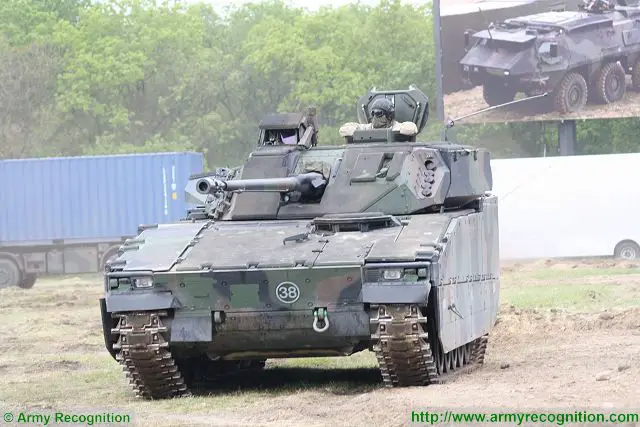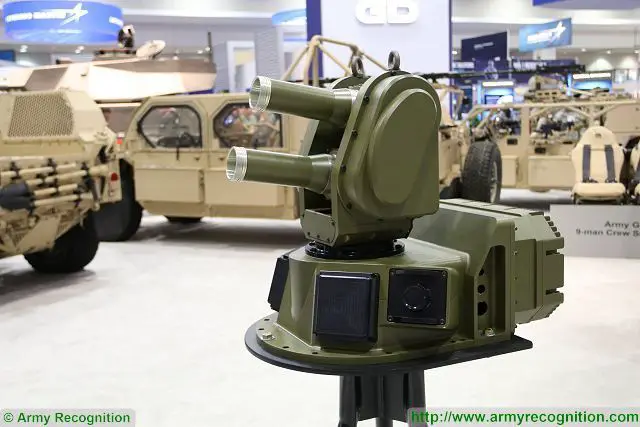|
|
|||
|
Defence & Security News - Netherlands
|
|||
|
|
|||
|
CV9035 IFVs from Army of Netherlands to be fitted with Israeli IMI Iron Fist active protection system.
|
|||
|
BAE Systems has received a contract from the Netherlands for the testing and verification of Active Protection Systems (APS) Iron Fist developed by the Israeli Company IMI (Israeli Military Industries) Systems to put on its CV90 Infantry Fighting Vehicles (IFVs).
|
|||
|
|
|||
 CV9035 IFV (Infantry Fighting Vehicle) from Dutch Army during live demonstration CV9035 IFV (Infantry Fighting Vehicle) from Dutch Army during live demonstration |
|||
|
|
|||
|
Active Protection is an advanced solution consisting of countermeasures that can intercept incoming rocket-propelled grenades, anti-tank missiles, and other threats to increase crew and vehicle survivability.
BAE Systems, the manufacturer of the Dutch CV9035 variant vehicles, will lead the APS integration. BAE Systems will also carry out the future installation of the system, called Iron Fist, developed by Israeli supplier IMI Systems. Iron Fist is an automated system that uses a radar to detect and track threats and then takes action to eliminate the threat. The IMI Systems Iron Fist combines a Soft-and Hard-Kill Active protection System especially designed to be mounted on a light armoured vehicles as IFVs (Infantry Fighting Vehicles). IRON FIST employs a sophisticated, multi-sensor early warning system, utilizing both infrared and radar sensors, providing the crew with enhanced situational awareness and early warning from potential threats. “Iron Fist will give the Dutch Army a highly sophisticated defensive tool on its CV90s to counter threats and improve the safety of the vehicle and its crew,” said Tommy Gustafsson-Rask, managing director of Sweden-based BAE Systems Hägglunds. “Iron Fist is yet another example of the advanced technology BAE Systems and its partners can deliver to our customers.” The integration of this advanced APS solution onto the Dutch CV90s demonstrates the vehicle’s adaptability to new and evolving technologies to meet customer-specific requirements. |
|||
|
|
|||
 New Iron Fist Light active protection system at the booth of General Dynamics Ordnance and Tactical Systems during AUSA 2016. New Iron Fist Light active protection system at the booth of General Dynamics Ordnance and Tactical Systems during AUSA 2016. |
|||
|
|
|||
|
“During this test phase we will pre-qualify the active system against our threat specification, and together with our partners analyze system safety and prepare for its integration onto our CV9035NL vehicles,” said Hans de Goeij, project manager at the Netherlands Defence Materiel Organisation, Ministry of Defence. “We expect to make a decision on the next phase by early 2018. With Iron Fist, the Netherlands is expected to become the first NATO country with an Active Protection System of its kind on combat vehicles.”
In December 2004 the Royal Netherlands Army awarded BAE Systems Hägglunds a EUR749 million contract for the supply of 184 CV9035 Mk III IFV/CV9035NL. The first vehicles will be delivered in 2007 through 2010. The CV9035NK is fitted with a two-man turret armed with a Bushmaster III 35mm caliber automatic cannon. A 7.62mm coaxial machine gun is mounted to the left side of the main armament. BAE Systems is a leader in the development of survivability technologies for combat vehicles. The company has, for example, developed a system called ADAPTIV, which uses cloaking technology to alter the appearance of a vehicle, making it harder to identify. BAE Systems has also developed a situational awareness tool called BattleView 360. BattleView 360 employs sensors outside the vehicle that feed a 360-degree image to a helmet-mounted monocle, allowing soldiers inside the vehicle to essentially “see through” armor and better detect threats. |
|||
CV9035 IFVs from Army of Netherlands to be fitted with Israeli IMI Iron Fist active protection system 12612161
- Posted On














